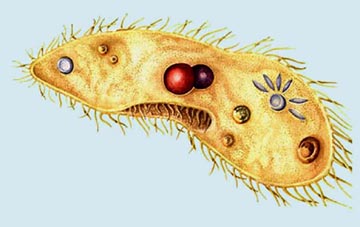
source of image (©Lizzie Harper)
Featured Organism: Paramecium
Notes for Chapter 11:
Protozoan Groups
Click link to return to Lecture
Schedule
or back to Chapter 8
or ahead to Chapter 12
CSUF classes will resume Wednesday Sept. 12
Chapter 11 Assignment:
Ch. 11: All; RQ-11: 1, 6, 8-11
Introduction: Emergence of Eukaryotes

source
of image (©Lizzie
Harper)
Featured Organism:
Paramecium
Other Featured Protists: Giardia, dinoflagellates, Euglena, Volvox, Codosiga (choanoflagellate), Amoeba, forams, radiolarians, Toxoplasma, Plasmodium
0. "Protozoa" - Good example of paraphyletic group
a. It is a functional/nutritional grouping, not a clade (monophyletic)
• Includes common ancestor of eukaryotes and many descendants
Excludes those whose body is partitioned into cells
(e.g., plants, fungi, metazoans)
Historically, "Protozoa" included only animal-like unicellular eukaryotes
(e.g., microscopic life in pond water)"Protozoologists" studied protozoans, especially parasitic forms
"Phycologists" studied plant-like unicellular eukaryotes (e.g., diatoms)
More recently, most use name "Protista" (protists) for all unicellular eukaryotes
Our text uses "Protozoa" as equivalent to most authors' "Protista" (see p. 214)
Our text only emphasizes the animal-like groups (see p. 236-237)
The multicellular red and brown algae are also included as protists by some
(so then "protists" are not all unicellular)Eukaryota is a clade (first organism with a nucleus and all its descendants)
Like "Protozoa," "Protista" is paraphyletic
We do not recognize it as a form taxon in this class ("Rule of Monophyly")
The authors (p. 236-237) use the outdated protozoologist names in this chapter
• They admit most these groupings are invalid, composed of unrelated taxa
• They are waiting for a newer "standardized" protozoan classification
• Such a classification is available and is generally agreed upon
• Exceptions usually involve where to put certain problematic taxa
• One reason they classify "Protozoa" like this is that they are not cladists
• Another is that the alternative is quite complicated
• Here is a cladistic classification of Eukaryota (about 27+ clades)
• Here is my attempt to sort out the classification in Hickman et al.
• Links to current tree overviews of eukaryotes: 1 - 2 - 3 - 4 - 5
• Link 4 above has the following relatively simple tree:
• Notice that Metazoa (animals) is grouped with fungi and then green plants
• Together these comprise a small portion of total eukaryotic diversity
• Choandoflagellates are likely even closer to animals but are not included hereClassification of Eukaryotes based on the above tree (unranked indented):
Eukaryota
diplomonads
microsporidians
clade 1 (with mitochondria)
parabasalians
clade 2
clade 3
kinetoplastids
euglenoids
clade 4
cellular slime mold
clade 5
alveolates
dinoflagellates
ciliates
clade 6 (eukaryotic "crown group")
chrysophytes
clade 7
rhodophytes (red algae)
clade 8
chlorophytes (green algae and land plants)
animal-fungi grouping
metazoans (animals)
fungib. The name "Protista" is more general, but still not a clade
c. Eukaryota is a clade, with taxon Metazoa nested inside it
I. Form and Function
Key Terms: nucleus, cytoplasm, locomotor organelles (pseudopodia, flagella, cilia), parts of flagellum (axoneme, basal body, centrioles), axopodia (Actinopoda), sliding microtubule hypothesis, division of labor among cells (only in some colonial forms), excretion vs. osmoregulation, contractile vacuoles, phagotrophs vs. osmotrophs, holozoic vs. saprozoic feeders, food vacuole (phagosome), cytostome, binary reprodction (binary fission)1, budding, multiple fission, schizogony, isogametes vs. anisogametes, syngamy vs. autogamy, conjugation
II. Representative types
Key Terms: chloroplasts (in "phytoflagellates" - see above), macro- vs. microgametes, "zooflagellates" - see above, test (e.g., Arcella and Difflugia), reticulapodia
Within Eukaryota, basal groups lack mitochondria (but have nucleus,
mitosis)
- example: Giardia
Mitochondria known to have arisen by endosymbiosis between early eukaryote and
alpha-purple bacterium
Plastids have arisen at least once and possibly multiple times from cyanobacteria
as eukaryote endosymbionts
- example: chloroplasts
Endosymbiosis between 2 eukaryotes is also known –> combined organism
- examples: euglenoplasts came from green algae, Mesodinium
is a ciliate + cyptomonadwith plastids of two separate origins
Eukaryote "protist" Examples Emphasized:
Giardia
– basal eukaryote without mitochondria
– nasty parasite from drinking stream water
Euglena
– widely studied as typical flagellate
– freshwater habitat
– plastid came from green alga
Amoeba
– widely studied "naked" amoeboid
– uses pseudopodial locomotion
with lobopodia– other "sarcodina" have test
and axopodia
forams, radiolarians
"ooze" on sea floors
"flagellates" or "amoeboids" are each polyphyletic
Heterokonts
diatoms – unicellular phytoplankton
kelp - multicellular
Alveolates
dinoflagellates
– important "phytoflagellates"– free-living or symbiotic
inside corals, anemones (zooxanthellae)
– includes "plants" & "predators"
ciliates (Paramecium)– highly diverse group
– usually large (10 µm to 3 mm)
– macro- and micronucleus
– conjugation – adults exchange haploid micronuclei, come away different
(Fig. 11-27)
apicomplexans
– endoparasites lacking motility– have "apical complex"
– Toxoplasma is cat parasite that also infects AIDS patients
– Plasmodium causes malaria, transmitted by
mosquitoes (see Fig. 11-20)
"Crown" eukaryotes:
Chlorophytes
– one or more cells
– green algae and land plants
– (+ red algae?)
– Volvox example of colony of cells
Fungi
Choanoflagellates (Codosiga)
– often colonial
– probably closest relative of animals (sister taxon)
– "collar" cells resemble feeding cells of sponges
Metazoa (multicellular animals)
Click link to return to Lecture
Schedule
or back to Chapter 8
or ahead to Chapter 12
This page created 9/9/01 © D.J. Eernisse, Last Modified 9/12/01, Links Last Completely Checked 9/9/01